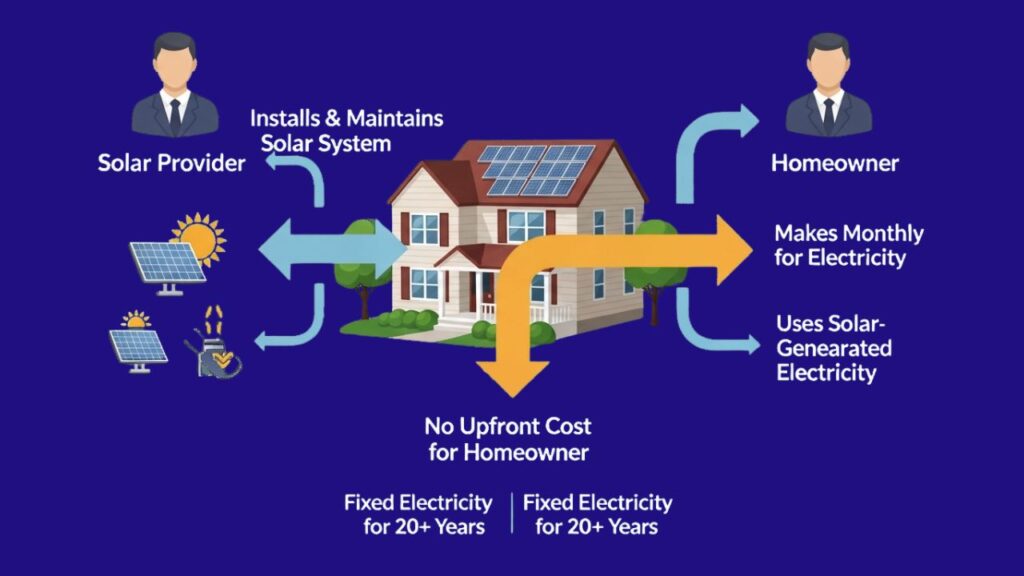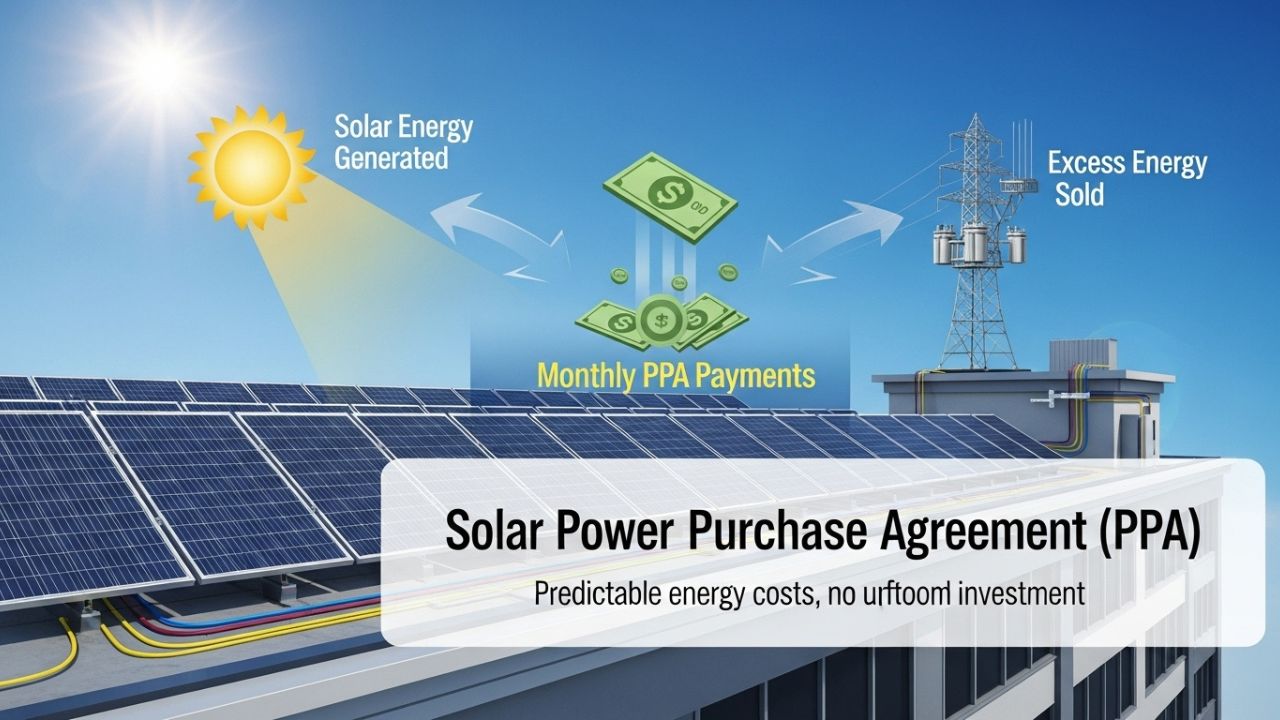The world is shifting toward clean and renewable energy, and solar power stands at the forefront of this revolution. However, one of the biggest barriers to solar adoption—especially for businesses and property owners—has always been upfront cost.
That’s where Solar Power Purchase Agreements (PPAs) come in.
A Solar Power Purchase Agreement allows a homeowner, business, or organization to go solar without paying the high initial investment. Instead, they agree to buy the electricity generated by the solar panels at a fixed, often lower, rate than traditional utility power.
In this article, we’ll break down everything you need to know about Solar PPAs—how they work, their advantages and disadvantages, legal considerations, real-world examples, and whether they’re the right fit for your energy needs in 2025 and beyond.
What is a Solar Power Purchase Agreement (PPA)?
A Solar Power Purchase Agreement (PPA) is a financial arrangement in which a third-party developer installs, owns, and operates a solar energy system on a customer’s property. The customer then agrees to purchase the system’s electric output for a predetermined period—usually 10 to 25 years—at an agreed-upon rate per kilowatt-hour (kWh).
In simple terms:
- You host the solar panels on your roof or land.
- The developer pays for the equipment, installation, and maintenance.
- You buy the electricity produced at a lower price than your current utility rate.
This model eliminates upfront costs while providing clean, predictable energy pricing.
How Does a Solar PPA Work?
Here’s a step-by-step breakdown of how a Solar Power Purchase Agreement typically works:

1. Site Evaluation
The solar provider evaluates your property’s energy needs, roof condition, shading, and structural layout to determine the best solar setup.
2. Proposal and PPA Agreement
Once the site is approved, the provider offers a proposal outlining:
- Electricity rate per kWh
- Contract duration
- Expected annual production
- Escalation rate (if applicable)
- Terms for ownership transfer or buyout
3. System Installation
After both parties sign the PPA, the solar provider installs and connects the system. The provider retains ownership and handles all permits, inspections, and grid connections.
4. Operation and Maintenance
Throughout the contract, the developer manages maintenance, repairs, and monitoring. You only pay for the electricity produced, not the equipment.
5. Payments and Savings
Each month, you receive a bill for solar electricity at the agreed rate, which is usually 10–30% lower than your local utility rate.
6. End of Contract Options
When the PPA term ends, you generally have three options:
- Purchase the system at fair market value
- Renew the agreement for continued service
- Have the system removed by the provider
Read Also: Revolution Under the Roof: How Invisible Solar Tiles Are Changing Home Design Forever
Types of Solar PPAs
There are a few main types of Solar Power Purchase Agreements depending on ownership, scale, and location:
1. On-site PPA
The most common model, where the solar system is installed on your property (rooftop or ground-mounted). The customer uses the electricity directly.
2. Off-site or Virtual PPA
Used mainly by corporations and institutions. The solar farm is located remotely, and power is sold to the grid. The buyer receives renewable energy credits (RECs) to offset their electricity use.
3. Community Solar PPA
This model allows multiple subscribers to benefit from a shared solar project. Each participant buys a portion of the energy produced, reducing costs without owning panels.
Key Benefits of Solar PPAs
1. Zero Upfront Cost
The biggest advantage of a PPA is that you don’t pay for the installation. The provider invests in the system, allowing you to access solar energy with no capital expense.
2. Lower Energy Bills
You pay only for the electricity generated—often 10–30% cheaper than traditional utility rates. Over time, these savings can be substantial.
3. Maintenance-Free Experience
The developer handles all system maintenance, performance monitoring, and repairs throughout the contract duration.
4. Environmental Impact
By choosing solar energy, you reduce your carbon footprint, support renewable energy production, and contribute to sustainability goals.
5. Energy Price Stability
PPA rates are typically fixed or have a small escalation rate, which protects you from rising utility prices over decades.
6. No Performance Risk
If the solar system doesn’t perform as expected, you don’t pay for underproduction—the provider bears that risk.
Potential Drawbacks of a PPA
No financial model is perfect. Here are a few considerations before signing a PPA:
1. Long-Term Contract
PPAs often last 15–25 years, which may not suit every homeowner or business. Early termination could result in penalties.
2. Limited Ownership Benefits
Since you don’t own the system, you cannot claim tax incentives or rebates—those go to the developer.
3. Property Sale Complications
If you sell your property, the new owner must either take over the PPA or you’ll need to buy out the system.
4. Escalation Clauses
Some PPAs include annual rate increases (1–3%) which could impact long-term savings.
Solar PPA vs. Solar Lease: What’s the Difference?
Both PPAs and solar leases help customers go solar with no upfront costs—but there’s a key difference in how payments are structured.
| Aspect | Solar PPA | Solar Lease |
| Payment Basis | Pay per kWh produced | Fixed monthly payment |
| Ownership | Developer | Developer |
| Risk of Underperformance | Developer | Developer |
| Savings Potential | Based on actual production | Based on fixed rate |
| Flexibility | Higher (pay for usage) | Predictable (flat rate) |
Verdict:
A PPA is often more beneficial if you want to pay only for actual energy consumption, while a lease suits those preferring a consistent monthly bill.
Who Can Benefit Most from a Solar PPA?
1. Commercial and Industrial Buildings
Businesses with large energy needs benefit immensely from PPAs—especially those with unused roof space. It reduces operating costs and enhances brand sustainability.
2. Municipalities and Nonprofits
Since these organizations often can’t take advantage of tax credits, PPAs allow them to enjoy low-cost solar energy without ownership.
3. Homeowners with Limited Capital
For homeowners hesitant about the high cost of solar installation, a PPA provides a risk-free entry into renewable energy.
4. Real Estate Developers
Integrating solar PPAs in new commercial or residential projects adds property value and aligns with green building standards.
Financial and Legal Considerations
Before signing a PPA, you should carefully evaluate the following:
1. PPA Rate
Compare your current utility rate with the proposed PPA rate to ensure real savings.
2. Escalation Clause
Check whether the rate increases annually and by how much.
3. Contract Term
Typical durations range from 10–25 years. Make sure it aligns with your future property plans.
4. Buyout Option
Understand when and how you can purchase the system, usually after 6–10 years.
5. System Performance Guarantees
Confirm that the developer provides production guarantees and monitoring reports.
6. Transfer Clause
If you sell your property, ensure the PPA is transferable to new owners.
7. Regulatory Compliance
Verify that your PPA complies with local energy laws and utility interconnection rules.
Real-World Examples of Solar PPAs
1. Amazon’s Renewable Energy Projects
Amazon has signed multiple virtual PPAs to power data centers with solar energy. These contracts ensure long-term energy stability while advancing their sustainability goals.
2. City of Los Angeles
The Los Angeles Department of Water and Power (LADWP) entered a massive PPA to source 400 MW of solar power, reducing carbon emissions and stabilizing energy costs.
3. School Districts and Universities
Institutions like the University of California system use PPAs to cut operational costs while showcasing environmental leadership.
How to Get a Solar PPA
Step 1: Research Providers
Look for reputable companies such as:
- Sunrun
- Tesla Energy
- SunPower
- NextEra Energy
- EDF Renewables
Step 2: Request Proposals
Get multiple quotes, review rates, escalation terms, and performance guarantees.
Step 3: Evaluate Financials
Compare projected savings with your current utility expenses.
Step 4: Legal Review
Have a professional energy attorney review the contract to ensure transparency.
Step 5: Sign and Install
Once satisfied, finalize the agreement and schedule installation.
Read Also: Solar Investment Bonds 2025: How to Earn Monthly Income from Sunlight
Future of Solar PPAs in 2025 and Beyond
The global solar PPA market is expected to exceed $300 billion by 2030, driven by corporate sustainability goals, government incentives, and declining solar costs.
Emerging trends include:
- Virtual PPAs for multinational corporations
- Blockchain-based PPA tracking for transparency
- AI-powered energy optimization to improve system efficiency
- Hybrid solar + battery PPAs to ensure 24/7 power reliability
Governments are also simplifying PPA regulations, encouraging more small and medium enterprises to adopt renewable energy contracts.
Frequently Asked Questions (FAQs)
1. Are PPAs available for homeowners?
Yes. Many residential solar companies now offer PPAs, especially in states like California, Texas, and Arizona.
2. Can I sell my home if I have a PPA?
Yes. The buyer can either assume the agreement or you can buy out the contract before selling.
3. What happens if the system underperforms?
You only pay for the electricity produced. The provider is responsible for maintaining optimal performance.
4. Do PPAs include battery storage?
Some providers now offer solar + battery PPAs, enabling energy use even during grid outages.
5. Can I claim tax credits under a PPA?
No. The system owner (the developer) claims federal and state tax incentives.
6. Is a PPA better than buying solar panels?
If you want ownership and long-term ROI, buying is better. If you prefer no upfront cost and low risk, a PPA is ideal.
Conclusion: Is a Solar PPA Right for You?
A Solar Power Purchase Agreement can be a game-changing solution for homeowners, businesses, and organizations seeking affordable access to clean energy without financial barriers.
With zero upfront cost, predictable energy pricing, and professional maintenance, PPAs remove most obstacles associated with solar ownership. However, it’s essential to carefully evaluate contract terms, compare providers, and ensure the agreement aligns with your long-term goals.
As the world races toward carbon neutrality, Solar PPAs are becoming a cornerstone of global renewable energy adoption—empowering individuals and enterprises to participate in a greener, more sustainable future.
